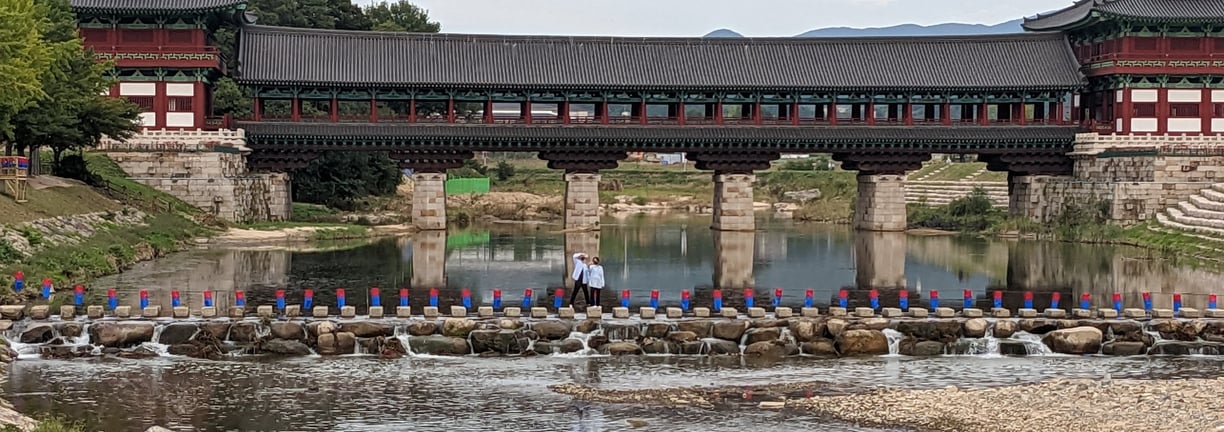Observations of a Traveler: Korea
Reflections on unique cultural, customs, and characteristics of the country
TRAVEL OBSERVATIONS
The Observations of Traveler series, is meant to summarize our observations and musings on each country we visit in sum, focusing on unique culture, customs, or physical characteristics that we notice. It is NOT meant to be a fully complete or accurate account of a people or a place. We are observers from the outside, often not knowing the language, and with limited time to interpret those people and places. Please do not take our observations with insult or as a truth. These observations are simply that, observations of travelers enjoying the experience and trying our best to understand the world around us.
It has now been a week or so since we departed South Korea. In total, we spent about five weeks there, a longer stretch of time than any other country we plan to visit. In truth, we only set our sights on this country after we thought Japan would be closed to tourists. And despite knowing quite a few Korean Americans and others who spent quite a bit of time here, I knew very few little about the country beside a few stereotypes and flimsy bits of history: they make good phones, K-POP is fun, Gangnum style, fashion is important there, that Americans fought here in some kind of miniature prequel to the Vietnam War...that's about it! Once there, we were delighted by the natural beauty (seems like every town was surrounded by verdant hills and misty rice fields), general kindness1, and overall ease/comfort/safety here. In the end, we both had a very positive impression of this country and its people and learned a lot along the way (although sadly only the number of Korean words I could count on one hand). Some of these are about etiquette, others about history or infrastructure or food or fashion, served up with no particular cohesion. Without further ado:
Interesting Etiquette
South Korea had some very specific modes of etiquette that differ from ours. I mentioned in the section above that talking and generally making any kind of noise on transit is a big no-no. A friend of ours who lives in Korea joked that a man and wife sitting next to each other on the subway will text each rather than talk. It's seriously silent and absolutely everyone is staring down at their phones. The experience is in some ways nice and some ways feels rather creepy.
Another interesting point of etiquette relates to handing or receiving items. This most apparent to us at cash registers, when the attendant would always return a card or change cupped in two hands. It turns out its rude to ever hand something to someone single-handedly. If it awkward to use two cupped hands or if you are being less formal (aka an older person handing something to a younger person), you might instead touch the elbow or forearm of then hand reaching out with your other hand. It took awhile to learn this habit, but eventually I got into the rhythm and realized I'm still doing it in Japan where the gesture isn't really important.
Other etiquite rules we learned in more detail from largely during our time staying in Ye's Park Ceramic's course from our hosts and relate largely to meal time. In general age and seniority (including men before women of course) are extremely important in South Korea. Thus, historically, a younger person would serve an older person and also wait for them to begin eating first. Additionally, its also seen as bad luck (or poor taste) to pour your drink, especially an alcoholic one. Hence, in a group setting one should always be rushing to pour drinks for everyone else and wait for them to pour you one. I found this fun but it also made it difficult to regulate your drinking, since it also seemed rude to really refuse if someone offered to pour you another round of soju--especially a Korean Ceramics Master!
I think much of this etiquette and aforementioned collectivism could become fairly burdensome. Luckily, non-Koreans are largely given a pass in regards to etiquette rules. Our poor form was either ignored or shrugged off with a friendly and understanding smile.
The fashion is funny to this not-particularly fashionable woman
One of things I had heard about Korea before we went was that its known as a paragon of fashion and that folks throughout Asia travel to malls of of Seoul and Busan to shop and see what Koreans are wearing. Well, the malls truly are spectacular (especially our beloved Lotte Mall in Busan). But I was truly baffled by the women's fashion here. I would describe the predominant women's fashion style here to be baggy boyfriend outfits. Super wide and baggy jeans and trousers are worn under over-sized sweatshirts or sweaters. Alternatively, T-shirt dresses or formless mid-calf length sack dresses with high collars were worn. More casually, work-out shorts are topped with over-sized long-sleeve shirts or hoodies with somewhat meaningless English phrases on them. Bucket hats and giant visors are a frequent accessory, but sadly my own favorite accessory, earrings, are not. My own, not well developed, fashion sense tends towards sporty, with black leggings as my best friend. Needless to say, these Korean styles were lost on me.
The Public Infrastructure is On Point
I've already crowed about the high quality transit systems in Korea in other posts, so I won't spend much additional time on that here, although its relevant. But Korea goes above in beyond for other public infrastructure as well. Parks (both urban and natural) always featured well maintained paths and trails. Public spaces were well lit and well signed (usually in multiple languages). Landscaping was beautiful and never marred with litter. And the cherry on top: the bathrooms! My fellow frequent travelers out there will probably agree, that finding public restrooms when you need them can be a point of anxiety when out touristing in a foreign place, let alone ones that are clean, not too smelly, and stocking toilet paper.4 Not so in South Korea. Anytime Shadie or I would start to think we could use a restroom we'd look up and find one in front of us.
Cute, cute, cute, cute, cute, cafes everywhere!
One thing we noticed from day one is the prevalence of cafes in Korea. I really cannot emphasize this enough; seriously, New York, Paris, and Florence do not a hold a candle to just about anywhere in South Korea. Cafes are absolutely everywhere. From downtown Seoul to the peaks of Seoraksan, you will find a café. Not only are they ubiquitous, they are visually stunning. Each café will undoubtedly have a beautiful window display, tasteful lighting, thoughtful and artistic interior design, and drinks poured in stylistic cups and served with colorful garnishes.
Yet, on the whole (with some notable exceptions) we found the actual drinks (coffee and tea), and host of cakes and pastries often served looked far better than they tasted. The coffee was oft burnt or conversely weak and oversweet. Also confusing to us, the cafes were almost never open at the time American's generally seek out coffee, aka the morning. In the first few days in the country, we'd move out bright and early, excited to check out a cute café spotted in-transit the previous day, only to find it closed until 11am.2 The impression left was that cafes are designed with the primary aim being to see and be seen and to snap aesthetic photos rather than for the substantive enjoyment of good drink and food in the morning hour.
Nonetheless, cafes were a frequent and enjoyable refuge, always (post 11am) available for us to rest our tired feet after a long day of sightseeing or provide a bathroom (although per my later section this blog post this was rarely needed). We took to pointing out cafes to each other and indicating the number of "cutes" its appearance deserved. Wasn't that cafe full of hanging potted plants cute, cute, cute, cute, cute, cute, cute? How about that one appointed with amber velvet settees? Cute, cute, cute, cute? I found most cafes and many other romantically oriented spots earned a good seven cutes.
Korea is a young country
If I were to assign a common theme to the experience of Korea it would be that the country feels young, almost like a "twenty-something." Now, hear me out. I know it's a strange sounding observation, especially given that humans have inhabited this era for a very long time, and with significant empires (like the Silla) dating back to beginning of the Current Era and before. Yet, still the country as it is today is young. Plagued by invasions from China, Japan and others for hundreds of years, Korea was, in many ways, the backwater of more militarily successful empires elsewhere and was most recently occupied by Japan starting at the beginning of the century until finally made independent with the defeat of Japan at the end of WWII. Japan treated Korea quite brutally and did a lot to try and Japanize it, outlawing its religious practices, language, customs etc. Shortly thereafter, the just-forming country was freshly traumatized and reshaped by the Korean war that split it apart from North Korea. So the nation of South Korea really only formed officially in 1948 and emerged from the split in the 1950's.
To me, it feels like the Korean culture hit reset at this time. Hangul, the country's written language (already one of the newest written in the world to begin with) resurged post independence. Development boomed throughout the 1960's, transforming Seoul into the high-rise metropolis it is today. Meanwhile, the 2nd largest city, Busan, went from a fishing village in 1950 to a major population center filled with refugees from the north and grew quickly as well. Perhaps also contributing to the youthful feel of the country is its ongoing economic boom. With that has come a lot of shiny new infrastructure and what seems like a youthful positivity and enthusiasm. This contrasts clearly with our experience in Japan thus far, where a decades long boom was followed by a severe economic bust in the 1990's which seems to have left both the infrastructure and overall attitude of the people a bit more somber and weathered.
Korean culture itself seems focused on many things I associate with youth today: from the prevalence of Instagrammability, tech savviness and forward infrastructure, to the obsession with cute couple activities and romance. I'll hit on some of these items a little bit more in below sections.
Footnotes
1) Because of the language barrier, we didn't get to spend quality time with many Koreans, mostly just Master Kwak, his wife, and our guide in Andong. Those three were absolutely warm and welcoming. Of course, we still interacted with a very many Koreans, and though we were clearly viewed as outsiders, I felt like we approach with good humor and reserved friendliness. They generally seemed happy to have us there, even as a bit of an oddity.
2) In fact, finding any kind of breakfast outside of a convenience store or a highly westernized restaurant can be quite challenging. Koreans apparently rarely eat breakfast outside of home or skip breakfast all together.
3) Many sit-down restaurants you will not serve parties of one. You need to order in sets meant for two or more. Ouch!
4) My orientation in speaking of restrooms is that of an American traveling in foreign countries, where I often don't know the lay of the land well or speak the language. But I actually feel like the US gets quite poor marks in the department. Our public bathrooms tend to be infrequent, in poor condition, or locked, while local businesses bar non-patrons or code lock them. In fact, one of two times I remember mostly acutely needing a bathroom and not finding one was in Santa Cruz California. The other was in very rural Mexico.
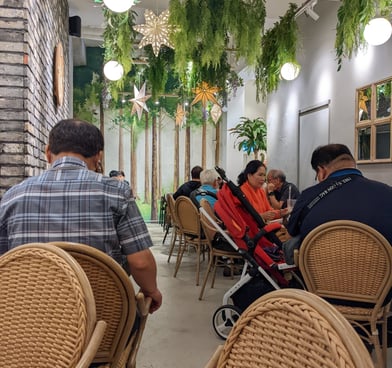

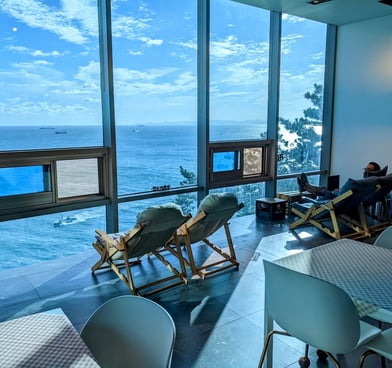

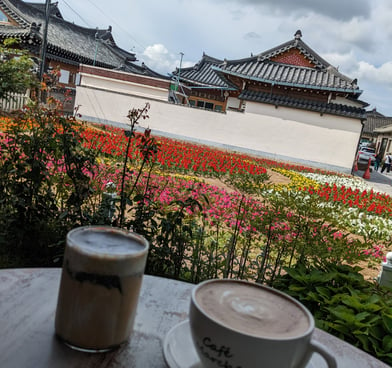

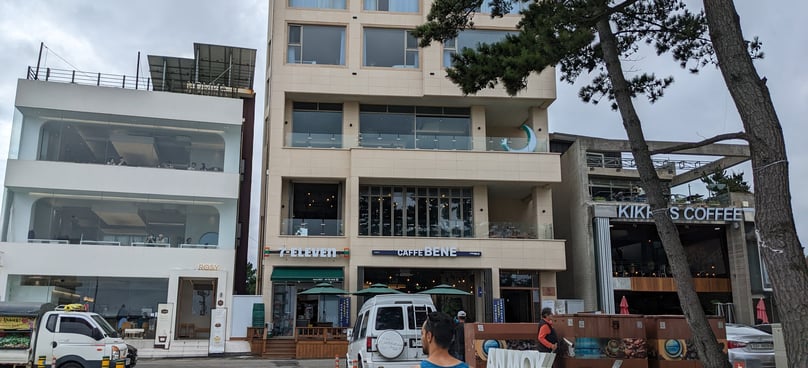

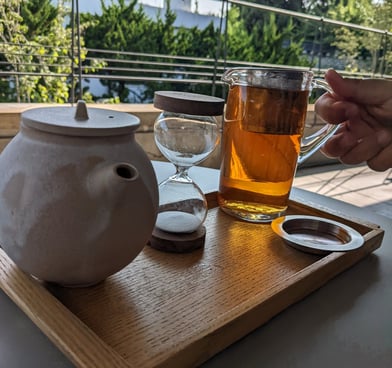

Korea is Safe
On a somewhat related note, since infrastructure plays such an important part in this, was the sense of security. Everywhere felt absolutely safe. I at one point asked our pottery instructor, Marco, if it was safe to jog at night. He laughed, and said you could jog at 2AM in the middle of Seoul and be totally safe. This certainly felt true. I never once felt uneasy, whether in empty allies or on crowded city streets. As an urban planner, I'm going to go out on a limb and wager some reasons why. Firstly, as Squid Games and other Korean shows clearly portray, there are class issues and folks down on their luck here, but overall Korea has enjoyed a long stretch of economic growth. Second, CCTV cameras are just about everywhere. Thirdly, weapons, notably guns but also most other weapons are strictly prohibited; police do not carry anything beyond a baton. A final big reason seems cultural. South Koreans rate much higher on the "collectivist (vs individualistic)" scale and are extremely rule abiding. We witness this often. For instance, jaywalking was almost non-existent. And, chatting on on the transit is discouraged in PR and on signs, and indeed the trains are virtually silent.
#romanticdestinationkorea
The cute, cute, cute, cute, cute, does not stop with the cafes. In fact, everywhere we turned in Korea, it seemed like there was a picture-worthy view framed up perfectly against a convenient backdrop. It was not uncommon to see signs in urban parks or along the beach indicating "Instagram viewpoint 50m ahead." Such views (already beautiful because of the verdant hills, rice fields, and lovely coastlines) were frequently supplemented by what in the urban planning field are called "placemaking" signs or objects. In this case, often quite literally giant 3D signs with the name of the place you were at. Many places also featured extensive lighting displays for evening enjoyment (think Zoo Lights but for every night). There were times when I felt like entire destinations existed solely for the available photo-opps.
The cute or romantic setups paired quite seamlessly with an apparent national obsession with romance. Once again France has nothing on Korea in this arena. At many scenic hilltops, coast-lines, or even museums, you would find vending machines selling love locks (aka small, often heart-shaped padlocks) that lovers could buy and lock to adjacent fences, bridges, etc. Said lovers are frequently wearing matching outfits (in some case identical), which is quite the trend here. Add to this that eating alone is frowned upon.3 Often this romantic bent was enjoyable if a bit kitschy for Shadie and I, but, man, I thought being singleton in the US was rough, and so can't imagine how brutal it would be here!
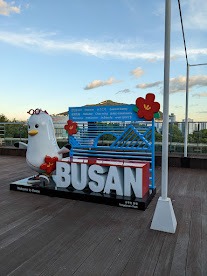

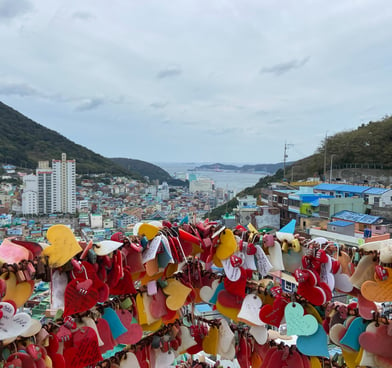

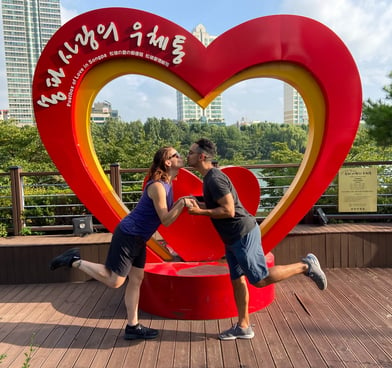

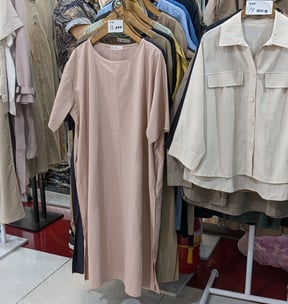

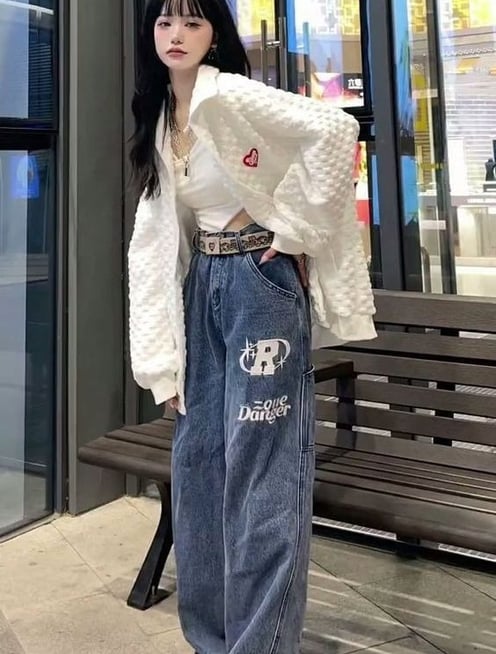

I was equally confused by the amount of layering and skin coverage. Along with baggy clothing was multiple layers and what seemed like truly excessive defense against sun exposure. On an 80 degree day, it was not uncommon to encounter folks wearing long pants, a thick hoodie, fingerless gloves, a hat, some strange stickers on their face (to protect their cheekbones?), and a face mask. At first I thought this might have to do with conservative values, but concluded it really was about sun exposure and was dumbfounded at how they weren't sweating right through all those layers of clothes! They take sun protection seriously!
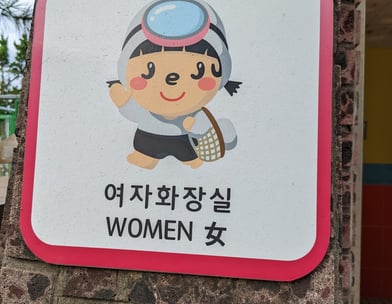

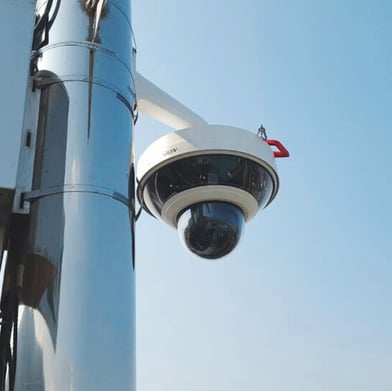

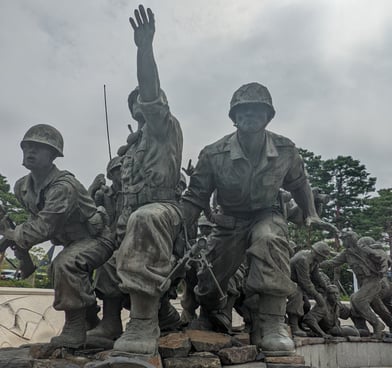

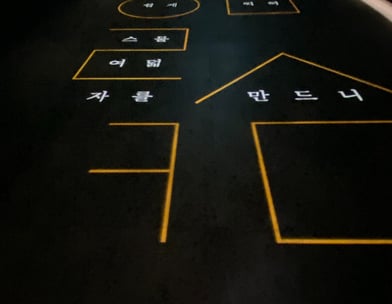

Just a few examples of the ubiquitous and visually pleasing cafes. With the exception of the very last, which served Osulloc tea (a brand of tea grown on Jeju I became a fan of) the drinks were meh to mediocre.
Top: A Korean War memorial. Bottom: the much celebrated Hangul, the written language of Korea, invented in 1443.
It was hard to choose just these four examples of the romantic photo-op and placemaking paraphernalia. If you look carefully at the photo below, you will notice a Korean couple in fully matching attire snapping a selfie!
A shapeless shirt-dress on sale.
I don't have any good demonstrative photos of live-action fashion, perhaps because its awkward to take pictures of strangers. So this is not my photo; hopefully the internet doesn't sue me.
This particular public bathroom, on Jeju, indicated the ladies side with this very cute Haenyeo!
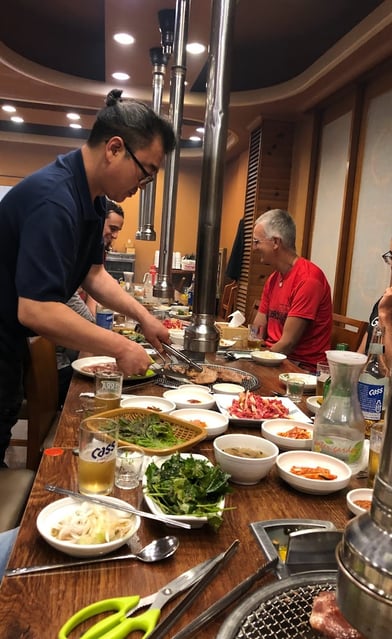

Master Kwak always took charge of grilling the meat. It seemed the senior man generally takes on this task according to etiquette...or maybe he just didn't want us accidentally burning his favorite cuts?
